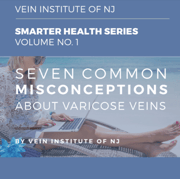“Wait!,” the patient said as we were about to painlessly zap and eradicate the spider veins on her thigh that had kept her from wearing shorts the past two summers. “Don’t I need that vein?” A great question, even if not the ideal time to pose it; but the answer is “No!” Depending on the type of procedure performed by our vascular doctors at the Vein Institute of New Jersey, and the type of vein treatment, the answer will be explained differently, but the bottom line is still “No!”
Telangiectasias (or spider veins) are small veins that form at the skin surface. They carry minimal amounts of blood away from the skin. Using injection Sclerotherapy techniques, the vascular doctors at the Vein Institute of New Jersey can obliterate these veins. The small amounts of blood that were carried in these vessels can be diverted elsewhere following treatment for spider veins without any effect whatsoever.
Reticular veins are the larger veins that are under the skin surface and appear as blue veins. These are larger than the spider veins and, therefore, carry more blood. However, removing them during treatment of veins causes no problem at all with blood flow in the legs. Again, much as with the telangiectasias, the blood is easily re-routed into the remaining veins.
The larger varicose veins tend to protrude above the skin surface and are much more noticeable than the other types of veins. While treatment of varicose veins does not cause any problem with circulation or blood flow, it is critical to examine the underlying veins for problems.
How Do Varicose Veins Develop?
Quite often, these veins develop because of bad (incompetent) valves in the larger deeper veins. In particular, the Greater Saphenous Vein (which runs from the ankle to the groin) often has poorly functioning valves that are at the root of the varicose vein problem. When the valves in the saphenous vein do not work well, blood backs up in that vein and the pressure within the vein increases. This leads to the development of varicose veins. Therefore, the treatment must be the removal of both the varicose veins that are the source of concern and the saphenous vein that is the source of the problem.
The vascular doctors at the Vein Institute of New Jersey remove the saphenous vein using minimally invasive laser ablation techniques. The saphenous vein, while an important vein, is not needed for adequate function of the leg veins. In fact, this is the vein that is often removed for heart bypasses without any problems.
Have more questions on veins? Contact us today for a personal consultation.
 Download our eBook: Seven Common Misconceptions About Varicose Veins
Download our eBook: Seven Common Misconceptions About Varicose Veins






